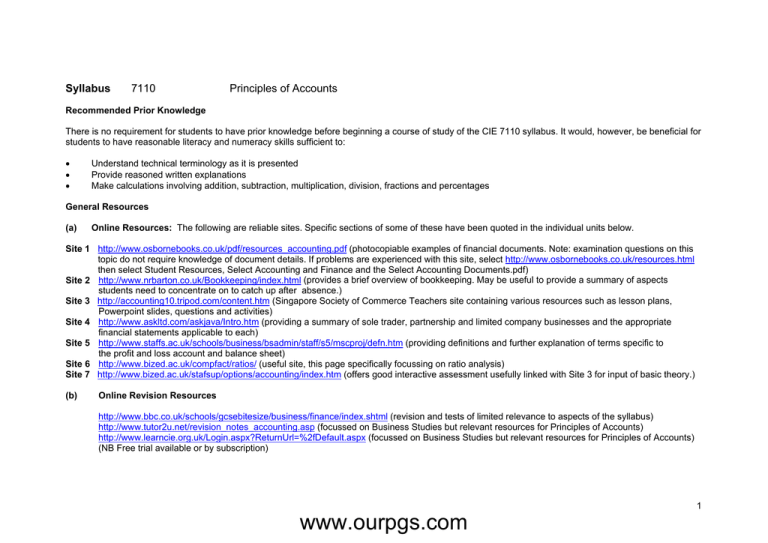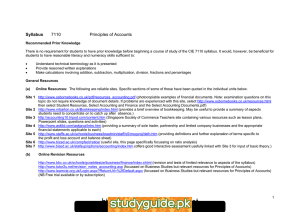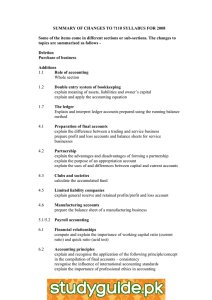Principles of Accounts-Scheme of work-Overview
advertisement

Syllabus 7110 Principles of Accounts Recommended Prior Knowledge There is no requirement for students to have prior knowledge before beginning a course of study of the CIE 7110 syllabus. It would, however, be beneficial for students to have reasonable literacy and numeracy skills sufficient to: • • • Understand technical terminology as it is presented Provide reasoned written explanations Make calculations involving addition, subtraction, multiplication, division, fractions and percentages General Resources (a) Online Resources: The following are reliable sites. Specific sections of some of these have been quoted in the individual units below. Site 1 http://www.osbornebooks.co.uk/pdf/resources_accounting.pdf (photocopiable examples of financial documents. Note: examination questions on this topic do not require knowledge of document details. If problems are experienced with this site, select http://www.osbornebooks.co.uk/resources.html then select Student Resources, Select Accounting and Finance and the Select Accounting Documents.pdf) Site 2 http://www.nrbarton.co.uk/Bookkeeping/index.html (provides a brief overview of bookkeeping. May be useful to provide a summary of aspects students need to concentrate on to catch up after absence.) Site 3 http://accounting10.tripod.com/content.htm (Singapore Society of Commerce Teachers site containing various resources such as lesson plans, Powerpoint slides, questions and activities) Site 4 http://www.askltd.com/askjava/Intro.htm (providing a summary of sole trader, partnership and limited company businesses and the appropriate financial statements applicable to each) Site 5 http://www.staffs.ac.uk/schools/business/bsadmin/staff/s5/mscproj/defn.htm (providing definitions and further explanation of terms specific to the profit and loss account and balance sheet) Site 6 http://www.bized.ac.uk/compfact/ratios/ (useful site, this page specifically focussing on ratio analysis) Site 7 http://www.bized.ac.uk/stafsup/options/accounting/index.htm (offers good interactive assessment usefully linked with Site 3 for input of basic theory.) (b) Online Revision Resources http://www.bbc.co.uk/schools/gcsebitesize/business/finance/index.shtml (revision and tests of limited relevance to aspects of the syllabus) http://www.tutor2u.net/revision_notes_accounting.asp (focussed on Business Studies but relevant resources for Principles of Accounts) http://www.learncie.org.uk/Login.aspx?ReturnUrl=%2fDefault.aspx (focussed on Business Studies but relevant resources for Principles of Accounts) (NB Free trial available or by subscription) www.ourpgs.com 1 (b) Online Revision Resources (cont’d) (c) http://www.bized.ac.uk/stafsup/options/accounting/test01.htm (objective assessment of double entry and the accounting equation) http://www.bized.ac.uk/stafsup/options/accounting/test02.htm (objective assessment of the trial balance, accruals and prepayments and accounting concepts) Further Reading Online http://www.accaglobal.com/publications/studentaccountant/technician/ (ACCA Student Accountant site with some relevant articles) (d) Links for Further Information: The list of websites provided is by no means exhaustive. Some of the sites in this scheme contain useful information on other topics in the syllabus and it is worthwhile navigating around some of the sites to extract further relevant information. Further websites may be obtained using a variety of search engines available. http://www.accountingeducation.com/links/index.cfm (useful to focus searching to relevant areas) http://www.carolworld.com/ (Company Annual Reports Online site, useful for illustrating commercial final accounts) http://www.google.co.uk/ (popular search engine) http://www.webfetch.com/ (meta-search engine – searches leading search engines) Hint: It is useful to be very specific when searching (e.g. ‘accruals’). A general search for, say, ‘accounts’ will bring up many non-relevant results. (e) Other Resources: http://teachers.cie.org.uk/teacher_support/o_level/o_level7110.htm (discussion group, up to date syllabus, examiner reports, question papers and frequently asked questions) Textbooks: A number of textbooks are included in the book list at the end of the syllabus. Space and clarity precludes references to all books on the book list in the scheme of work. Without acting as a recommendation for specific texts, references are given to the following three texts as examples: BKA IGCSE MB Book-keeping and Accounts 6th Edition (2004) (Frank Wood and Sheila Robinson, FT Prentice Hall) ISBN 0 273 68548 1 IGCSE Accounting (2002) (Catherine Coucom, Cambridge) ISBN 0 521 89346 1 Mastering Book-keeping 6th Edition (2003) (Dr Peter Marshall, How To Books) ISBN 1 85703 897 5 A reference to BKA 2 in the scheme of work refers to Chapter 2, Book-keeping and Accounts; MB 24 to section 24 in Mastering Book-keeping and so on. www.ourpgs.com 2 UNITS The syllabus for 7110, Principles of Accounts, is divided under five headings. These are further sub-divided into ten manageable Units below in the scheme of work. In allocating time over the course, sufficient should be left for revision and practice on past examination questions and thinking about examination technique as well as teaching. It is important for this syllabus and future studies that students gain a thorough understanding of double-entry principles so sufficient time should be allocated to the initial aspects of the syllabus to provide a solid foundation for future work. Questions set under teaching activities should be graded, beginning with a very simple task and then progressively getting harder. Unit Unit title Percentage time allocation Unit outline Syllabus references 1 Books of Prime Entry 10% Documentary records; books of prime entry; cash book; the general journal 1.2; 1.3; 1.4; 1.5 2 The Ledger and Trial Balance 15% The accounting equation; double entry system of bookkeeping; the ledger; the trial balance; suspense account; correction of errors 1.1; 1.3; 1.4; 1.6; 1.7; 2.4, 3.2 3 Accounting Adjustments 15% Matching concept; capital and revenue expenditure; accounting for depreciation; accruals and prepayments; bad debts; provision for doubtful debts; provision for discounts 2.1; 2.2; 2.3, 5.2 4 Control Accounts 5% Control accounts 2.5 5 Final Accounts – Sole Trader 10% Trading and profit and loss accounts; gross and net profit; columnar accounts; balance sheet; working capital; liquidity; asset valuation; capital and capital employed 2.4; 3.1; 3.2; 4.1 6 Final Accounts – Partnerships; Purchase of a Business 10% Trading and profit and loss accounts; appropriation account; balance sheet; capital and current accounts; formation of a partnership; purchase of a business; goodwill 3.1; 3.2; 3.3; 4.1; 4.2; 2.6 7 Limited Companies 10% Trading and profit and loss accounts; appropriation account; balance sheet; share capital and loans 3.1; 3.2; 4.5 www.ourpgs.com 3 Unit Unit title Percentage time allocation Unit outline Syllabus references 8 Manufacturing Accounts 5% Manufacturing or production accounts; direct and indirect costs; prime cost; cost of production 4.6 9 Clubs and Societies and Incomplete Records 10% Income and expenditure account; receipts and payments account; balance sheet; interim calculations and statements and final accounts from incomplete records 4.3; 4.1; 4.4 10 Advanced Principles 10% Ratio analysis, financial relationships; stock valuation; accounting principles and concepts 5.1; 5.2 TEACHING ORDER Teachers may prefer to begin the course with the Cash Book to show the effect of double entry or by showing how changes in assets and liabilities affect the Accounting Equation and balance sheet in preference to the above order of Units. However, it is suggested that the subject matter of Units 1 to 4 are completed before moving on to final accounts. Unit 10 should also be covered last as it relies on understanding of earlier Units. The rationale for the above order is: 1) Documents can be linked with purchases and sales which will be within the understanding of students. This can be progressed into the books and records used within a business 2) Double entry and the ledger follows on after the books of original entry (or at the same time in the case of the cash book) with trial balance as the arithmetical check and outcome of ledger postings 3) Adjustments are considered at the stage between trial balance and final accounts as they occur at the year end 4) Control accounts link a number of the earlier topics and provide a check of books of original entry with the ledger 5) The progression in final accounts of different organisations enables students to study, build understanding, and revise www.ourpgs.com 4

